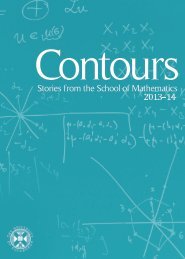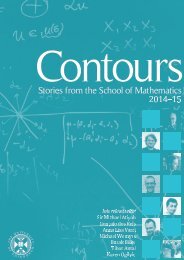Contours 2016-17
Stories from the School of Mathematics. Undergraduate students interview researchers to find out what the life of a mathematician is like.
Stories from the School of Mathematics. Undergraduate students interview researchers to find out what the life of a mathematician is like.
You also want an ePaper? Increase the reach of your titles
YUMPU automatically turns print PDFs into web optimized ePapers that Google loves.
<strong>Contours</strong><br />
Stories from the School of Mathematics
The team<br />
IMAGE CREDITS<br />
P7: ©ISTOCK.COM/DANIL MELEKHIN<br />
P8: ©ISTOCK.COM/ALEKSANDARVELASEVIC<br />
P13: ©ISTOCK.COM/EDWARDSAMUELCORNWALL<br />
P14: ©ISTOCK.COM/IGOR ZHURAVLOV<br />
2 <strong>Contours</strong>
Contents<br />
4<br />
6<br />
7<br />
8<br />
10<br />
12<br />
14<br />
16<br />
18<br />
20<br />
22<br />
23<br />
<strong>Contours</strong> 3
Projects: Knot as hard as they seem<br />
Fourth Year Project<br />
■<br />
4 <strong>Contours</strong>
Summer Vacation Project<br />
■<br />
◄ The output from Imogen's Matlab<br />
program, showing a 12x24 Celtic<br />
plait, with each link component<br />
of the plait coloured differently.<br />
Find out more about options for the<br />
summer vacation scholarships online:<br />
www.wiki.ed.ac.uk/display/SciEngSc<br />
hol/Scholarships+Overview<br />
<strong>Contours</strong> 5
MathPALs<br />
All first‐year students can take part in a weekly MathPALs session<br />
led by two higher‐year students who have been trained in Peer<br />
Assisted Learning.<br />
The sessions are informal, giving students a chance to ask<br />
questions and meet other students on the course – as well as<br />
benefiting from the experience of the higher‐year students.<br />
“the best way to<br />
learn and improve is<br />
to ask questions,<br />
and to learn from<br />
other peoples’<br />
experiences”<br />
■<br />
6 <strong>Contours</strong>
The Alan Turing Institute<br />
■<br />
Why Alan Turing?<br />
There is no doubt that Alan Turing is<br />
a giant in the world of computer and<br />
data science. During the Second<br />
World War, Turing played a pivotal<br />
role in decoding intercepted German<br />
messages – work which is thought to<br />
have shortened the length of the war<br />
by two to four years. But Turing was<br />
also a pioneer in computer science,<br />
taking steps towards artificial intelligence<br />
many years before it became a<br />
mainstream idea. It was partly thanks<br />
to his ability to combine techniques<br />
from mathematics, computing and<br />
statistics that Turing was so successful,<br />
and so he truly represents the<br />
spirit of modern data science research.<br />
Naming the institute after<br />
Alan Turing seeks to to give people a<br />
visionary understanding of its aims.<br />
<strong>Contours</strong> 7
From molecules to Big Data<br />
8 <strong>Contours</strong>
■<br />
Thermostat methods<br />
Say we want to find out the distribution<br />
of certain particles in a system.<br />
The movement of these particles can<br />
be simply modelled using Newton’s<br />
equations. In reality, this model is<br />
fairly poor, because it doesn’t take<br />
into account friction, and other<br />
forces, amongst the particles. Taking<br />
these forces into account, we obtain<br />
a modelling equation with two extra<br />
terms.<br />
But when we simulate the system using<br />
the equations, we find that the<br />
temperature of the simulated system<br />
changes over time, when this<br />
doesn’t actually happen in real life.<br />
To solve the problem, mathematicians<br />
like Ben and his PhD student<br />
Xiaocheng Shang introduce what’s<br />
called a ‘thermostat’ into the system.<br />
Like a thermostat that keeps a<br />
house a constant temperature, a<br />
thermostat in this context is an extra<br />
term in the modelling equation that<br />
regulates the temperature of the<br />
model. Similarly, when studying<br />
large sets of data, introducing a<br />
thermostat is essential to remove<br />
the ‘noise’ that appears when<br />
sampling.<br />
Various thermostat methods exist,<br />
but the traditional ones are not appropriate<br />
when looking at such large<br />
sets as those studied in Big Data research,<br />
being either too slow or too<br />
inaccurate. The method produced by<br />
Ben and Xiaocheng has performed<br />
very well in tests, converging much<br />
faster than former methods, and<br />
having a high accuracy. Similar<br />
methods are also used by Google, in<br />
machine learning – the study of pattern<br />
recognition. It’s this that allows<br />
Google to optimize its search results<br />
so that you can find what you’re<br />
looking for faster.<br />
►<br />
<strong>Contours</strong><br />
9
Hunting for Data<br />
“You get to derive<br />
cool results and then<br />
on top of that you<br />
can play with<br />
numbers”<br />
10 <strong>Contours</strong>
XKCD.COM/1132<br />
▲ This is one of Ruth's favourite XKCD comics. Next year, Ruth will be teaching<br />
a postgraduate course called Bayesian Theory, as part of the newly<br />
established MSc in Statistics with Data Science.<br />
■<br />
Statistics is very important in Big<br />
Data research because statistical<br />
modelling allows you to deal with<br />
missing data in formal ways. The<br />
techniques Ruth has worked on can<br />
be really useful when your data set<br />
is imperfect, for example, if you<br />
don’t have full access to people’s<br />
salaries because of privacy.<br />
Ruth is on the programme committee<br />
for the Alan Turing Institute (see<br />
p.7), providing advice regarding the<br />
scientific and innovation programmes<br />
for the institute, and is<br />
also a part of the recruitment committee<br />
for the institute.<br />
<strong>Contours</strong> 11
The Stochastic Nature of Life<br />
“Research is not<br />
always easy. It can be<br />
a lengthy procedure,<br />
and sometimes<br />
frustrating as things<br />
often don’t work out<br />
the way you intend<br />
them to. As such, it’s<br />
imperative to really<br />
enjoy the process, not<br />
just the end result.”<br />
12 <strong>Contours</strong>
■<br />
José is one of the founding members<br />
of the Edinburgh Mathematical<br />
Physics Group. Founded in 1999, it<br />
is a joint research institute made up<br />
of the Mathematics departments of<br />
the University of Edinbugh and Heriot‐Watt<br />
University. The group covers<br />
many areas of research, including<br />
Gravitational physics, noncommutative<br />
geometry and field theory<br />
amongst many others.<br />
To find out more on the group visit<br />
https://empg.maths.ed.ac.uk/<br />
<strong>Contours</strong> 13
Great Waves<br />
“...you have to go<br />
further than anyone<br />
else to make<br />
progress. You’re way<br />
more likely to do<br />
that if you’re<br />
passionate about<br />
what you’re doing.”<br />
14 <strong>Contours</strong>
■<br />
Maths in Action<br />
This year, Lyuba has been teaching a<br />
brand new course which is closely<br />
related to her research interests.<br />
Mathematics in Action is aimed at<br />
students in years 4 and 5, and focuses<br />
on using mathematical techniques to<br />
analyse real‐world data – usually<br />
building on mathematics that appears<br />
in earlier courses. The course is very<br />
hands‐on, giving practical experience<br />
of analysing data in Matlab – ranging<br />
from comparisons of different imageprocessing<br />
methods, to analysing Met<br />
Office data on the mean temperature<br />
in Scotland.<br />
<strong>Contours</strong> 15
Analysing a Hiro<br />
“His office is full of<br />
academic books, and<br />
when asked if he has<br />
any hobbies, Hiro<br />
gestures towards the<br />
books and says: ‘I<br />
think of mathematics<br />
as a hobby’”<br />
16 <strong>Contours</strong>
■<br />
<strong>Contours</strong> <strong>17</strong>
Travels in mathematics<br />
“This could have<br />
been a safe position<br />
for a settled life…<br />
I decided to try<br />
something new”<br />
18 <strong>Contours</strong>
▲ Vanya's Brompton bike has been with him around the world. These are just a few of the images he has posted on his<br />
website – you can see the full collection at www.maths.ed.ac.uk/cheltsov/brompton<br />
■<br />
<strong>Contours</strong> 19
Spreading Inspiration<br />
20 <strong>Contours</strong>
■<br />
▼ As an undergraduate, David made a series of stained glass windows to illuminate mathematical concepts he found<br />
inspiring. The common tile motif at top and bottom is a ‘proof by pictures’ of the Pythagorean theorem.<br />
Perhaps you can try and figure out why!<br />
1 The Klein bottle, and its ‘fundamental<br />
group’.<br />
2 A proof that the same number, pi, is the ratio<br />
of a circle's circumference to its diameter,<br />
and of its area to the square of its<br />
radius.<br />
3 Designed by David's brother, Alex Jordan,<br />
this depicts Tartaglia's solution of the cubic<br />
equation.<br />
4 The golden spiral, and its relationship to the<br />
Fibonacci numbers and the golden ratio.<br />
<strong>Contours</strong> 21
Why Mathematicians Should Knit<br />
■<br />
22 <strong>Contours</strong>
Puzzles<br />
Stuck? Solutions are on the website:<br />
www.maths.ed.ac.uk/contours<br />
Sangaku problems were hung on tablets in shrines and temples during<br />
the sakoku period (1639‐1853) in Japan. Since the country was secluded<br />
in those years, Japanese mathematicians used a distinct kind of mathematics<br />
known as wasan to solve the problems.<br />
In the School, Professor José Figueroa‐O'Farrill (p. 12) offers a 4th year<br />
project which involves studying some sangaku, and their connections<br />
with Western approaches to similar problems.<br />
ρ<br />
ρ<br />
The radius of each<br />
circle is written at<br />
its centre.<br />
Show that R=5r.<br />
1 2<br />
3<br />
4<br />
Maths<br />
Cryptic<br />
No 2<br />
r .<br />
R<br />
<strong>Contours</strong> 23





